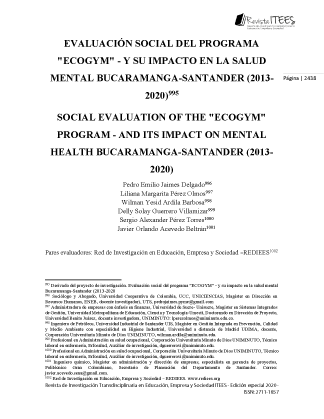CXXIX. SOCIAL EVALUATION OF THE "ECOGYM" PROGRAM - AND ITS IMPACT ON MENTAL HEALTH BUCARAMANGA-SANTANDER (2013- 2020)
##plugins.themes.bootstrap3.article.main##
Abstract
The motivations taken into account for the development of this research are based on the
premise that current governments and territorial entities in general require the impact
assessment of the investment that has been carried out in the new public administration
model. It is necessary to have knowledge about the productivity of public spending, and in a
special way, about the impact on mental health and the construction of peace in the
beneficiaries of the Open Air Parks programs -ECOGYM- that leads to evaluate the
effectiveness and efficiency of results and effects. Based on the study of the impact, decisions
can be made on public policy, especially on programs related to mental health, favoring
public policies and therefore have a positive impact on all citizens.
This study aims to make a contribution from the academy to the knowledge of the impacts
emanating from the ECOGYM programs in terms of mental health and peacebuilding, both
of the beneficiaries and their environments, since many of them are found influenced by
youth gangs or patches, as well as groups of young people prone to the consumption,
distribution and commercialization of the different types of drugs and alcohol, which in many
cases have been diminished by sports. From here, a direct relationship is established between
the social sport plans, the benefits and of course the impacts of this archetype that will make
it possible to provide recommendations for improvements in the implementation of new
parks or in the maintenance of existing ones.
Download Statistics
##plugins.themes.bootstrap3.article.details##
ECOGYM, mental health, construction of PEACE, public policies, parks
public health: a conceptual model. Am J Prev Med. 2005;28 (2):159-168.
CEPAL –Naciones Unidad y el Instituto Latinoamericano y del Caribe de Planificación
Económica y Social (ILPES) Banco Mundial y el Instituto Latinoamericano y del
Caribe de Planificación Económica y Social, Navarro H, (2015) Manual para la
evaluación de impacto de proyectos y programas de lucha contra la pobreza. Santiago
de Chile Recuperado de:
http://repositorio.cepal.org/bitstream/handle/11362/5605/S053168_es.pdf;jsessionid
=46F177B3E4 EBC046D974646D862FD249?sequence=1
González C, Calcetero J, (2009) Evaluación de Impacto Social: Una estrategia de
Investigación, Revista tendencias y retos No. 14.
Del Campo, C., Bermúdez, G., Peluffo, S., & Del Campo, J. (2016). Gimnasios al Aire Libre
como estrategia de promoción de salud. Usuarios y características de uso en
Uruguay. Tendencias en medicina, 48, 66-73.
Frank LD, Sallis JF, Saelens BE, Leary L, Cain K, Conway L, Hess PM. “The development
of a Walkability Index: Application to the neighborhood Quality of Life Study.”
British Journal of Sports Medicine. 2009. Available:
http://bjsm.bmj.com/content/early/2010/04/22/ bjsm.2009. 058701.full.
Fisher KJ, Li FZ, Michael Y, Cleveland M. Neighborhoodlevel influences on physical
activity among older adults: a multilevel analysis. J Aging Phys Act. 2004; 12:45- 63.
Kaczynski AT, Johnsons AJ, and Saelens BE. “Neighborhood land use diversity and physical
activity in adjacent parks.” Health and Place. 2010; (2) 413-415.
Kruchelski S, Rauchbach R. CrutibAtivagestaonascidadesvoltada a promocao da atividade
física, esporte, saude e lazer: Avaliacao, prescricao e orientacao de atividade física e
recreativas, na promocao de saude e hábitos saudáveis da populacaocurtibana.
Curtiba R
Organización Mundial de la Salud (1986) Carta de la Ottawa para la promoción de la salud
"Salud para Todos en el año 2000" Recuperado de: http://www.promocion.salud.gob.mx/dgps/descargas1/promocion/2_carta_de_ottaw
a.pd f
Rauchbach. 2005:149. 13. Kaczynski AT, Henderson KA. “Environmental Correlates of
Physical Activity: A review of Evidence about Parks and Recreation.” Leisure
Sciences. 2007; 29: 315-54.
Puig, N. y Maza, G. (coords.) (2008). El deporte en los espacios públicos urbanos.
Monográfico de Apunts. Educación Física y Deportes (91).
Puig, N.; Vilanova, A.; Camino, X.; Maza, G.; Pasarello, M.; Juan, D. y Tarragó, R. (2006)
Los espacios públicos urbanos como generadores de redes sociales. El caso de la
ciudad de Barcelona. Apunts. Educación Física y Deportes (84), 76-87.
Mowen A, Kaczynski TL, Cohen D. The potential of parks and recreation in addressing
physical and fitness. President´s Council on Physical Fitness and Sports. 2008;9(1):1-
8
Mitchell R., Popham F, 2008. “The effect of exposure to natural environment on Health
inequalities: an observational population study.” The Lancet 372(9650):1655-1660.
Sallis JF, Millstein RA, Carlson JA. Making Healthy Places: Community Design for Physcial
Activity pp 33-49 Available: http://link.springer.com/ chapter/10.5822/978-1-61091-
0361_2page-2.
Tinsley HE, Tinsley DJ, Croskeys CE. Park usage, social milieu, and psychosocial benefits
of park use reported by older urban park users from four ethnic groups. Leisure
Sciences. 2002; 24:199-218.
Roemmich JN, Epstein LH, Raja S, Yin L, Robinson J, Winiewicz D. Association of access
to parks and recreational facilities with the physical activity of young children. Prev
Med. 2006;43(6):437-441.
Van den Berg AE, Mass J, Verheij RA, Groenewegen PP. “Green space as a buffer between
stressfull life events ans health” Social Science & Medicine. 2010;70(8):1203-1210.
Wendel-Vos GC, Shuit AJ, de Niet R, Boshuizen HC, Saris WH, Kromhout D. Factors of
physical environment associated with walking and bicycling. Med Sci Sports Exerc.
2004; 36:725-730.
Villada E, Sepúlveda N, (2009). El mejoramiento físico integral como mediador positivo en
el rendimiento de la actividad laboral y la prevención de la enfermedad en adultos,
usuarios del Gimnasio de la Casa Club del Egresado de la Universidad de Medellín.
Recuperado de: http://viref.udea.edu.co/contenido/pdf/192-elmejoramiento.pdf
Graw Hill.
Vidarte J, Velez C, Sandoval C, Alfonso M, (2011) Actividad Físicca: ESTRATEGIA DE
PROMOCIÓN DE LA SALUD. Red de Revistas Cientifica de America Latina y el Caribe,
ESpaña y Portugal. Recuperado de:
http://www.redalyc.org/articulo.oa?id=309126695014





